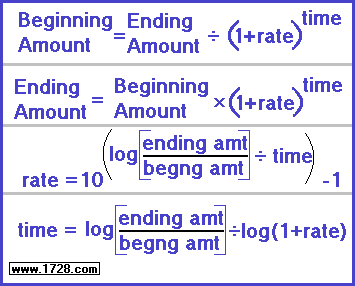|
Based on common logs and base 10 exponents To see exponential growth based on natural logs and the exponent "e", click here. To read about exponential decay particularly half-life, click here.

Using the calculator is quite simple:
What was the bacteria population at the beginning of the experiment (five hours ago.)?
Beginning Amount = 70,000 ÷ (1.3)5 Beginning Amount = 70,000 ÷ 3.71293 Beginning Amount = 18,853 * * * * * * * * * * * * * * * * * * * * * * * * * * * * * * * * * * * * * * * * * * * * * * * * * * * * * * * * * * * *
In 2020, it had a population of 450,000. What was its population in 2018?
We first have to calculate the annual population growth rate.
We then solve the equation by taking logs of both sides which yields: (1 + population rate) = 0.0087739243223 ÷ 10 Looking up the anti-log of 0.00087739243223 we get: 1.0020223129 which is the annual growth rate. We raise this number to the 8th power and then multiply it by the 2010 population:
(1.0020223129)^8 * 441,000 * * * * * * * * * * * * * * * * * * * * * * * * * * * * * * * * * * * * * * * * * * * * * * * * * * * * * * * * * * * *
What is the annual interest rate of this account?
We don't have actual numbers so we will substitute 1,000 for beginning amount and 2,000 for ending amount. Rate = 10(log[2,000 / 1,000] ÷ 9) -1 Rate = 10(0.301029995663981 ÷ 9) -1 Rate = 10(0.0334477772959979) -1 Rate = 8.005973889231% * * * * * * * * * * * * * * * * * * * * * * * * * * * * * * * * * * * * * * * * * * * * * * * * * * * * * * * * * * * *
How long will it take the population to triple? (That is, when will the population be 21,000?)
Rate = 10(log[Ending Amount / Beginning Amount] ÷ time) -1 For every 3 hours, we see that the population increases by a factor of 13,026 / 7,000 Rate = 10(log[13,026 / 7,000] ÷ 3) -1 Rate = 10(log[1.86085714285714] ÷ 3) -1 Rate = 10(0.2697130338238070 ÷ 3) -1 Rate = 0.229997828197444 Now, we can solve for the time. Time = log(ending amount / beginning amount) ÷ log (1 + rate) Time = log(21,000 / 7,000) ÷ log (1.229997828197444) Time = 0.477121254719662 ÷ 0.0899043446079357 Time = 5.30698774125259
Answers are displayed in scientific notation and for easier readability, numbers between .001 and 1,000 will be displayed in standard format (with the same number of significant figures.) The answers should display properly but there are a few browsers that will show no output whatsoever. If so, enter a zero in the box above. This eliminates all formatting but it is better than seeing no output at all.
Copyright © 1999 - 1728 Software Systems |
|||